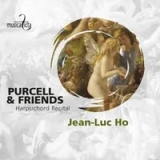Das abwechslungsreiche Programm, das der französische Cembalist Jean-Luc Ho spielt, erlaubt es ihm einmal mehr, seine einfallsreiche Gestaltungsmöglichkeiten zu zeigen. So kann er die Vielfalt von Purcells Formen und Ideen zum Ausdruck bringen, und dasselbe auch in den Stücken anderer Komponisten zeigen.
Ho spielt auf einem zweimanualigen Cembalo, das Émile Jobin als Kopie eines Instruments von Vincent Tibaut angefertigt hat. Das im Urzustand erhaltene Original ist datiert 1691 und wird im Musée de la Musique in Paris aufbewahrt. Eine genaue Beschreibung ist im Booklet zu finden.
Das Cembalo hat einen eher hellen und sehr klaren Klang und erlaubt es Ho, ausdrucksvoll zu musizieren.
Seine Tempi sind maßvoll und flexibel, so dass Anmut, Raffinesse und Leichtigkeit, die diese Musik verlangt, ihren Ausdruckscharakter nicht verhindern. Man spürt förmlich, mit welchem Drang Ho Purcells melodische Erfindungsgabe mit tollen Farbwerten, einem großen Detailreichtum und kunstvollen Verzierungen benutzt, um zu kommunizieren und zu zeigen, dass Purcells Cembalostücke die lebhafte Ausdruckskraft seiner Theatermusik teilen.
Hos Instrument kann bedeutsam reden, unruhig kommentieren, bukolisch lachen und zärtlich traurig klingen…
The varied program played by French harpsichordist Jean-Luc Ho once again allows him to demonstrate his imaginative interpretative possibilities. This allows him to express the diversity of Purcell’s forms and ideas, and to do the same in pieces by the other composers.
Ho plays on a two-manual harpsichord made by Émile Jobin as a copy of an instrument by Vincent Tibaut. The original, which has been preserved in its original state, is dated 1691 and is kept in the Musée de la Musique in Paris. A detailed description can be found in the booklet.
The harpsichord has a rather bright and very clear sound and allows Ho to play expressively.
His tempi are moderate and flexible, so that the grace, refinement and lightness that this music demands do not hinder its expressive character. One can literally feel the urge with which Ho uses Purcell’s melodic inventiveness with great color values, a wealth of detail and elaborate ornamentation to communicate and demonstrate that Purcell’s harpsichord pieces share the vivid expressiveness of his theatrical music.
Hos instrument can speak meaningfully, comment uneasily, laugh bucolicly and sound tenderly sad…
























